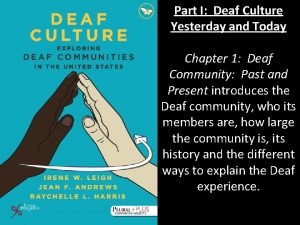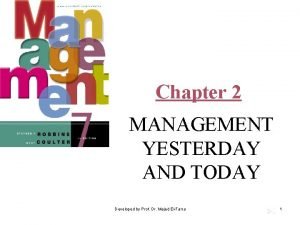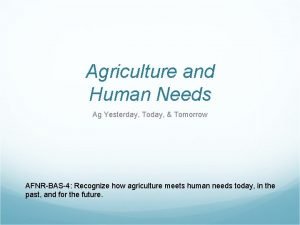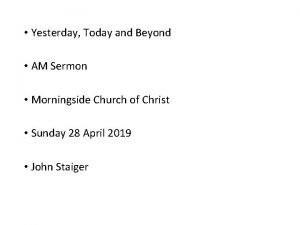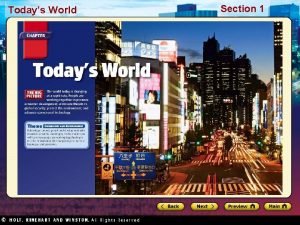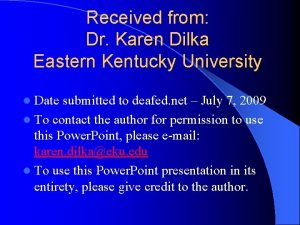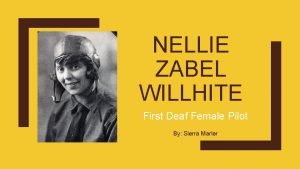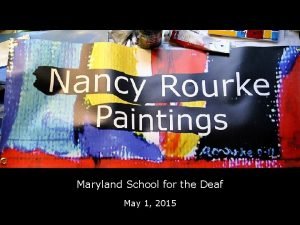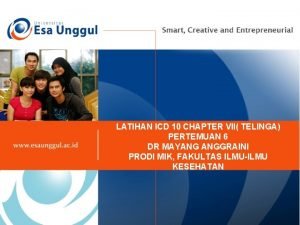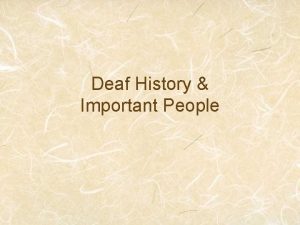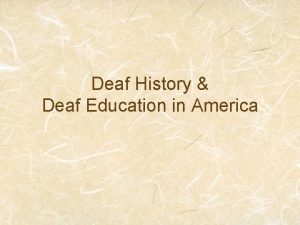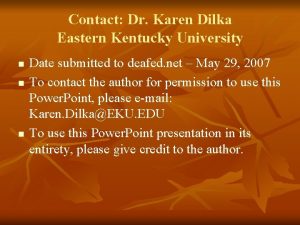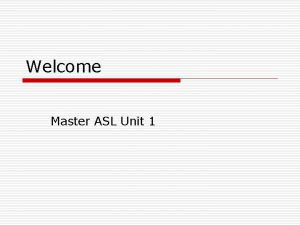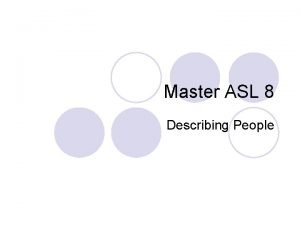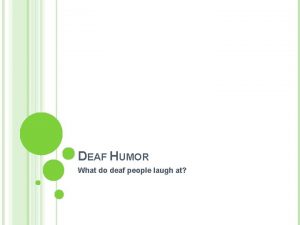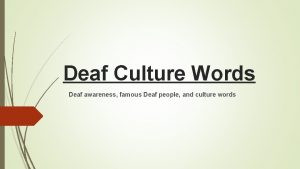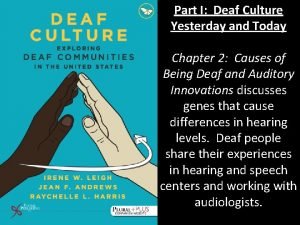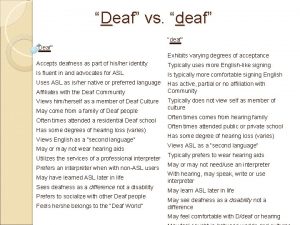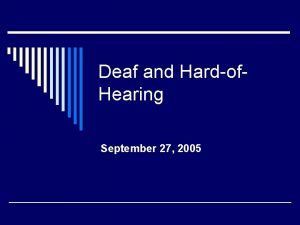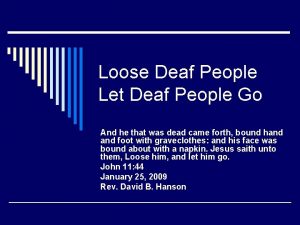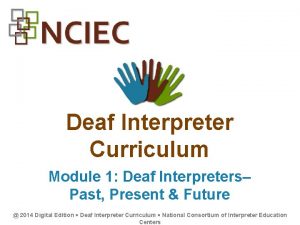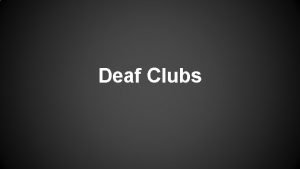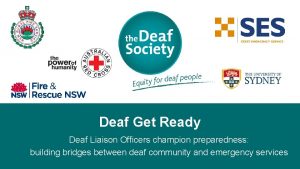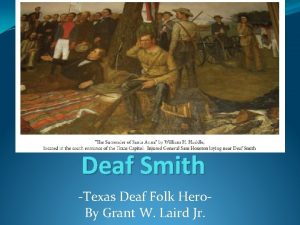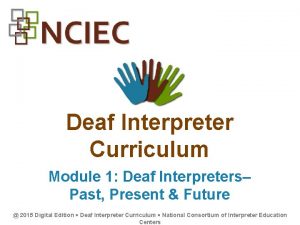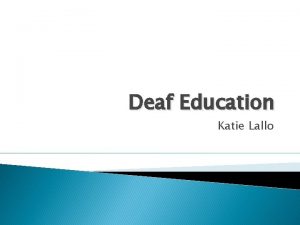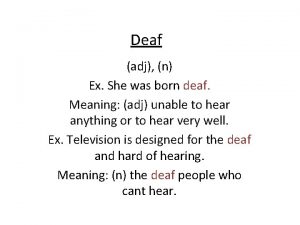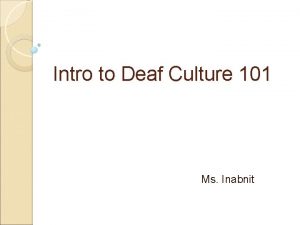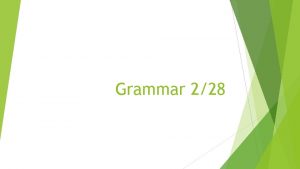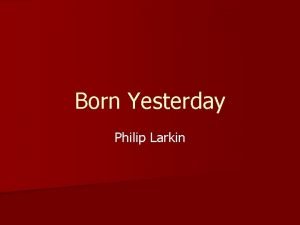Part I Deaf Culture Yesterday and Today Chapter





































- Slides: 37

Part I: Deaf Culture Yesterday and Today Chapter 1: Deaf Community: Past and Present introduces the Deaf community, who its members are, how large the community is, its history and the different ways to explain the Deaf experience.



Culture involves values, beliefs, social forms and traits of a group of people. Those values represent specific meanings, beliefs and practices that guide the group in individual and social development. (Leigh, Andrews & Harris, 2018, p. 5 -6)

Common Perspective of Deaf People • • • Disabled? Unable to communicate? Limited in what they can do or learn? Isolated? Unable to connect with the world? This perspective is often why many look to medicine to “cure” hearing loss. Hearing aids or cochlear implant surgery are often suggested, to “help” deaf people to “hear”. (Leigh, Andrews & Harris, 2018, p. 3) © Plural Publishing, Inc. 2018

Medical vs. Cultural Perspective There are often two contrasting perspectives: • One perspective: Cochlear implants support access to the hearing world and help with hearing and speaking. • The other perspective: Cochlear implants hurt the deaf community because the focus is on hearing and speaking and not on sign language, which is visual and accessible. (Leigh, Andrews & Harris, 2018, p. 4) © Plural Publishing, Inc. 2018

deaf and Deaf deaf: individuals who tend to rely on auditory assistance devices, prefer to use spoken language, and tend to socialize more often with hearing people. Deaf: members of Deaf culture. These people use sign language and share similar beliefs, values, customs and experiences. They often prefer to socialize with culturally Deaf people. (Leigh, Andrews & Harris, 2018, p. 4 -5) © Plural Publishing, Inc. 2018

Deaf Culture In Deaf culture, Deaf people do not see themselves as tragically isolated from society. Deaf people see benefits to being Deaf that many are unaware of. Deaf culture involves beliefs, artistic expressions, behaviors and language expressions that Deaf people use. Some people are born into the culture or join later after meeting other Deaf people. This is similar to gay or lesbian people finding their culture while growing up. (Leigh, Andrews & Harris, 2018, p. 4 -7) © Plural Publishing, Inc. 2018

Successful Deaf People You might have seen sign language and Deaf people in the media, including TV and movies. Shoshannah Stern is one example. Do you know more names of Deaf people in the media? We also have Deaf medical doctors and lawyers! (Leigh, Andrews & Harris, 2018, p. 4)

Cultural Capital Cultural capital involves the use of cultural knowledge, skills, abilities and interactions to influence resistance to disadvantages. Deaf cultural capital wealth looks at being Deaf as a positive attribute. This promotes resiliency in the face of difficult experiences. Visual language, visual learning and connections with Deaf people are examples of Deaf cultural capital wealth. (Leigh, Andrews & Harris, 2018, p. 7) © Plural Publishing, Inc. 2018

Deaf Communities Deaf communities have existed for centuries! The term, Deaf culture, became popular in the 1980 s. Deaf people often have little interest in knowing how well one can hear or speak. Deaf people are complete. They live full and rewarding Deaf lives. What are same terms and phrases used to describe deaf people? (Leigh, Andrews & Harris, 2018, p. 7) © Plural Publishing, Inc. 2018

Identifying Deaf People Negative Labels • Auditory Handicap • Hearing Impaired • Hearing Handicapped • Deaf Mute • Prelingually Deaf • Deaf and Dumb Those focus on what the Deaf person cannot do. (Leigh, Andrews & Harris, 2018, p. 7 -8) Preferred Labels • Deaf • Hard of Hearing Some call hearing people who do not understand Deaf culture or sign language: deaf impaired © Plural Publishing, Inc. 2018

Deaf Communities The Deaf community is not just one community. There are many diverse characteristics of Deaf people. • Ethnic/Racial identity • Born in US and those who arrive later • Sign language skills • Hearing levels • Religion (Leigh, Andrews & Harris, 2018, p. 8) • • • Political opinion Socioeconomic status Sexual orientation Educational level Additional disabilities © Plural Publishing, Inc. 2018

Examples of Deaf Community Members Deaf Children of Deaf Parents: Inheritors of Deaf culture, often growing up immersed in the Deaf community and using sign language. Deaf Children of Hearing Parents: Over 95% of deaf children are born to hearing parents. Those children may later meet Deaf people and learn about the Deaf community. (Leigh, Andrews & Harris, 2018, p. 8 -9) © Plural Publishing, Inc. 2018

Examples of Deaf Community Members Hearing Members in Deaf Families: Deaf children may have hearing siblings. Hearing children of Deaf adults are called CODAs. Deaf people might marry hearing people who are fluent signers. Hard-of-Hearing Individuals: Individuals with mild or moderate hearing levels, who rely more on hearing and speechreading. Some with mild or moderate hearing levels prefer to be called Deaf. (Leigh, Andrews & Harris, 2018, p. 10) © Plural Publishing, Inc. 2018

Examples of Deaf Community Members Late-Deafened Individuals: People who become deaf after age of 18 due to illness, workplace noise, genetics or medication. They often grieve for their lost hearing and try wearing hearing aids or opt for cochlear implant surgery. Some choose ASL and the Deaf community. Deaf. Blind People: Some are born Deaf. Blind, some become blind gradually, some are born blind, then become deaf later. The Deaf. Blind community is a vibrant community, not usually embraced by the Deaf community due to fear and discomfort. (Leigh, Andrews & Harris, 2018, p. 11 -12) © Plural Publishing, Inc. 2018

How Many Deaf People Are There? • Approximately 360 million people worldwide have hearing loss. • Approximately 17% of the U. S. population (or 36 million people) have hearing loss. • Roughly 2 to 3 of every 1, 000 children in the U. S. are born deaf. • It is estimated that there are between 360, 000 to 512, 000 Deaf ASL speakers in the U. S. • It is projected that Latinx, Asian and African American Deaf people will become the majority, and white Deaf people will become the minority. (Leigh, Andrews & Harris, 2018, p. 12 -13) © Plural Publishing, Inc. 2018

Historical Highlights • Deaf people have been around since the dawn of humanity. The earliest records of deaf people include ancient Egypt, Greece and Rome as well as the times when the Old and New Testaments were created. • During those times, some societies accepted deaf people and some societies rejected deaf people. Next, you’ll see examples of many different books about Deaf History. (Leigh, Andrews & Harris, 2018, p. 13 -14) © Plural Publishing, Inc. 2018


Historical Perceptions • Acceptance of Deaf people in society: Deaf people worked as farmers, painters and craftspeople as well as provided services in court system because they could keep secrets. • Rejection of Deaf people in society: Deaf people were assumed to lack reason, and therefore could not learn; deaf people could not own property; could not marry or do legal transactions. (Leigh, Andrews & Harris, 2018, p. 14) © Plural Publishing, Inc. 2018

Historical Highlights • In the 1500 s, people realized that deaf people could be educated. • In the 1700 s, families in the United States would send their deaf children to schools in Europe. • In 1817, the first formal school for the deaf was established in Connecticut: American Asylum for the Education of the Deaf and Dumb. This school still exists, renamed as the American School for the Deaf (ASD), pictured on the next slide. (Leigh, Andrews & Harris, 2018, p. 13 -14) © Plural Publishing, Inc. 2018



Historical Highlights • Towards the end of the 1800 s, sign language was considered primitive and suppressed in favor of the “superior” language, which was spoken English. • Mabel Hubbard Bell, the wife of Alexander Graham Bell was deaf, chose to speak, and preferred to associate with hearing people. • Deaf communities at that time strongly advocated for sign language to be used in schools. (Leigh, Andrews & Harris, 2018, p. 16) © Plural Publishing, Inc. 2018

Mabel Hubbard Bell with her husband, Alexander Graham Bell and their two daughters.

Historical Highlights At the 1880 International Congress on the Education of the Deaf in Milan, only one out of 164 participants was deaf. The vote at that conference to endorse speech over sign language was a landslide. This is an example of how hearing people decided what was best for deaf people. (Leigh, Andrews & Harris, 2018, p. 16) © Plural Publishing, Inc. 2018

James Denison, the principal at Kendall School in Washington, DC was the only deaf delegate at the 1880 International Congress on Education of the Deaf. He voted against the motion to support only spoken language for deaf students.

Historical Highlights Schools for the deaf were segregated until after the U. S. Supreme Court’s 1954 Brown v. Board of Education decision. The African-American Deaf community and the white American Deaf community did not have opportunities to socialize with each other. (Leigh, Andrews & Harris, 2018, p. 18) © Plural Publishing, Inc. 2018

Sense of Community Deaf people stayed in touch after graduation through: Living close to their local deaf school, establishing their own churches, deaf clubs, deaf associations, conventions for deaf people, sports events and more. (Leigh, Andrews & Harris, 2018, p. 18) © Plural Publishing, Inc. 2018

Historical Highlights In 1880, National Association for the Deaf (NAD) was founded. This organization works to advocate for deaf people who face discrimination in education, employment, politics and language choices. This organization was founded by Deaf people and always led by Deaf people. (Leigh, Andrews & Harris, 2018, p. 18) © Plural Publishing, Inc. 2018

Historical Highlights There have been Deaf sports teams since the 1800 s. Pictured in the next slide is a deaf baseball team in 1898. In 1924, the French Deaf Sports Federation hosted the first International Silent Games in Paris, France. This tradition continues today, renamed as Deaflympics. Today there are 104 deaf national sports federation members, representing different countries all over the world. (Leigh, Andrews & Harris, 2018, p. 18) © Plural Publishing, Inc. 2018


Historical Highlights Gallaudet University, the world’s only liberal arts university for deaf students, located in Washington, DC advertised a presidential vacancy in 1988. All of the previous presidents were hearing. It was time for a deaf president. A hearing person was selected! The Deaf community protested, and the next slide shows a picture of a rally during the week-long protest that captured the attention of the nation. (Leigh, Andrews & Harris, 2018, p. 19) © Plural Publishing, Inc. 2018


Contemporary Descriptions Deaf-World: Not an actual geographical location, but describes Deaf people who share common traits such as sign language and Deaf culture. Deafhood: Deaf consciousness that involves processing and reconstruction of a Deaf identity. (Leigh, Andrews & Harris, 2018, p. 20 -21) © Plural Publishing, Inc. 2018

Contemporary Descriptions Deaf Gain: Deaf gain is the opposite of a hearing loss, and involves contributions Deaf people make to society in general. Deaf Ethnicity: Deaf people are an ethnic group because of their biological similarity, shared language and kinship. (Leigh, Andrews & Harris, 2018, p. 22 -23) © Plural Publishing, Inc. 2018

Contemporary Descriptions People of the Eye: People living in a highly visual world; shifts the attention from “can’t hear” to deaf people as visual beings. This does not apply to people who are Deaf. Blind. Enjoy your journey into Deaf culture! (Leigh, Andrews & Harris, 2018, p. 24) © Plural Publishing, Inc. 2018
 Deaf culture
Deaf culture Management yesterday and today summary
Management yesterday and today summary Agriculture- yesterday today and tomorrow
Agriculture- yesterday today and tomorrow Yesterday, today and forever sermon
Yesterday, today and forever sermon Today's problems come from yesterday's solutions
Today's problems come from yesterday's solutions My day yesterday
My day yesterday Royal family yesterday today is tomorrow
Royal family yesterday today is tomorrow For todays meeting
For todays meeting In todays class
In todays class Today meeting or today's meeting
Today meeting or today's meeting Today lesson or today's lesson
Today lesson or today's lesson Today's lesson or today lesson
Today's lesson or today lesson Example of repitition
Example of repitition Non material culture definition
Non material culture definition Continuous culture and batch culture
Continuous culture and batch culture Indian culture vs american culture
Indian culture vs american culture Stab culture and stroke culture
Stab culture and stroke culture Folk culture and popular culture venn diagram
Folk culture and popular culture venn diagram Folk cultures are spread primarily by
Folk cultures are spread primarily by Stroke culture method
Stroke culture method Homework due today
Homework due today Anaerobic culture method
Anaerobic culture method Lawn or carpet culture method
Lawn or carpet culture method Surface culture deep culture and esol
Surface culture deep culture and esol The world today part 1
The world today part 1 Dr andrew foster deaf
Dr andrew foster deaf Who was the first deaf teacher in america?
Who was the first deaf teacher in america? Nellie willhite
Nellie willhite Harry williams deaf artist
Harry williams deaf artist Deaf icd 10
Deaf icd 10 Aristotle deaf
Aristotle deaf Founded the first american school for students who are deaf
Founded the first american school for students who are deaf Dr andrew foster deaf
Dr andrew foster deaf Hear us from heaven jared anderson
Hear us from heaven jared anderson Question maker face asl
Question maker face asl Asl describing a person order
Asl describing a person order How do deaf people laugh
How do deaf people laugh Ben cohen deaf
Ben cohen deaf
